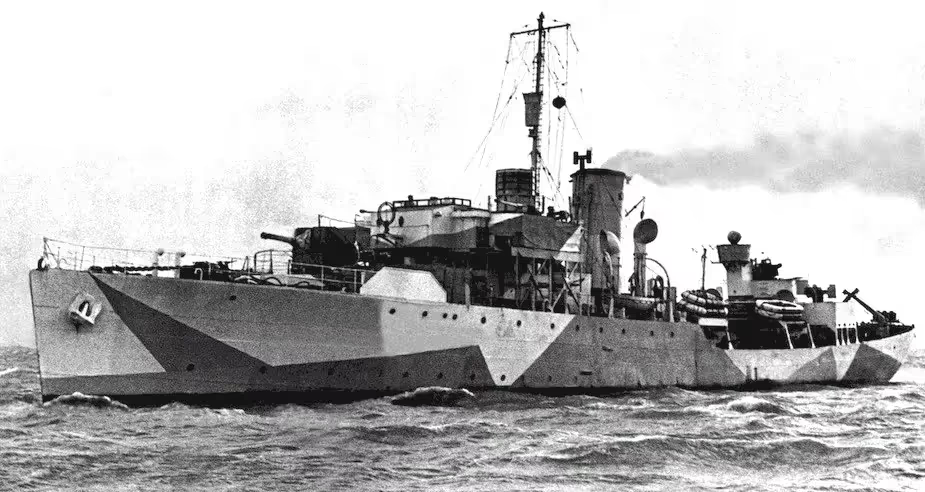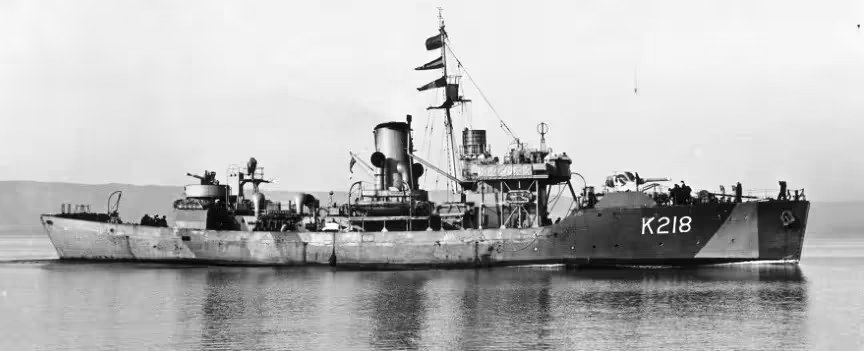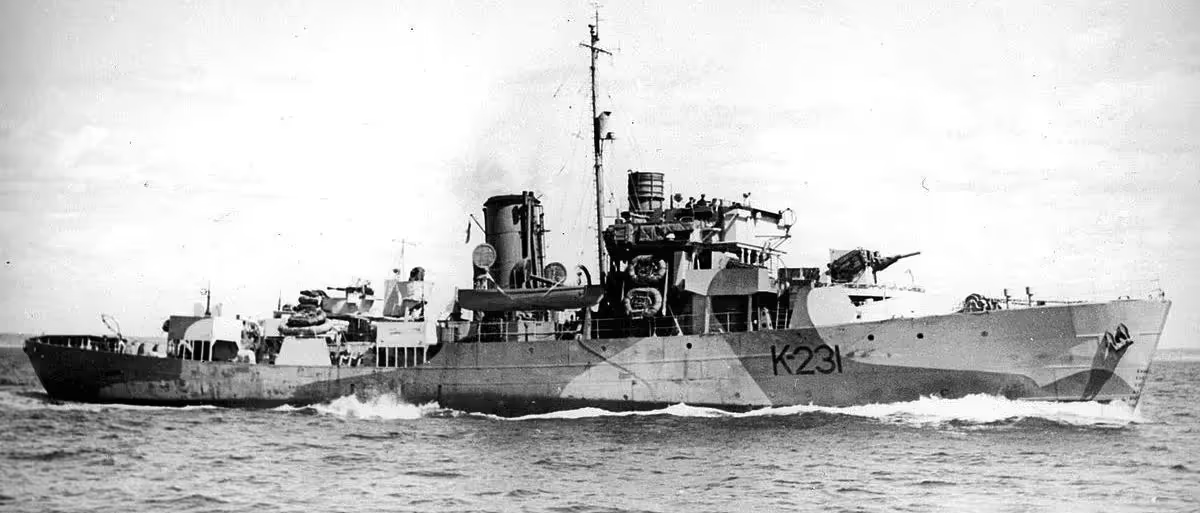RCN Corvettes (Flower Class): HMCS Belleville K332/HMCS Bittersweet K182/HMCS Brandon K149/HMCS Brantford K218/HMCS Buctouche K179/HMCS Calgary K231/HMCS Camrose K154/HMCS Chambly K116
HMCS Belleville (K332)

(RCN Photo)
HMCS Belleville (K332) (Flower-class). Commissioned at Kingston on 19 Oct 1944, she visited the Ontario port for which she was named before leaving for Halifax, where she arrived early in Nov 1944. HMCS Belleville continued fitting out at Halifax until Mid-Jan 1945, then sailed to Bermuda for a month's working-up. Further repairs followed on her return, after which she was allocated to EG C-5, leaving St. John's on 28 Mar 1945 to join her first convoy, HX.346. She made three Atlantic crossing before the war's end, leaving Londonderry for the last time at the beginning of Jun 1945. She was paid off on 5 Jul 1945, and placed in reserve at Sorel until 1947, when she was sold to the Dominican Republic and re-named Juan Bautista Combiaso. She was broken up in 1972.

(Library and Archives Canada Photo, MIKAN No. 3205104)
HMCS Belleville (K332) (Flower-class), 23 October 1943.
HMCS Bittersweet (K182)

(RCN Photo)
HMCS Bittersweet (K182) (Flower-class). Built at Sorel for the RN, she was launched on 12 Sep 1940. HMS Bittersweet was towed to Liverpool, NS for completion so as not to be icebound. She was commissioned 23 Jan 1941 at Halifax as HMS Bittersweet K182. On 5 Mar 1941, she left with convoy HX.113 for the Tyne. There, from 1 Apr 1941 to 6 Jun 1941, the finishing touches were carried out. During this refit, on 15 May 1941, she was transferred to the RCN and commissioned as HMCS Bittersweet K182. After working up at Tobermory she left for Iceland on 27 Jun 1941, having been assigned to Newfoundland Command. She was continuously employed as an ocean escort until 31 Dec 1941, when she arrived at Charleston, SC for refit, resuming her duties in Mar 1942. Bittersweet served with EG C-5 and C-3 until Oct 1943, one of her most strenuous convoys being ONS.192, which lost seven ships. She underwent refit at Baltimore, MD, possibly from Dec 1941, & May 1942, but recorded as Oct 1943 to Nov 1943, which included the extension of her fo'c's'le, then proceeded to Pictou to work up. She then resumed her convoy duties, leaving Londonderry late in Oct 1944 to join her last convoy, ON.262. Upon arriving in Canada she went to Pictou to commence a refit that was completed at Halifax 10 Feb 1945. She was then assigned briefly to Halifax Force before transferring in April to Sydney Force, with which she remained until the end of the war. She was paid off and returned to the RN at Aberdeen on 22 Jun 1945, and broken up at Rosyth the following year.

(Wayne Maize Photo)
HMCS Bittersweet (K182) (Flower-class), preparing to be towed by HMCS Skeena, May, 1943. The light line has just been passed in order to pass the heavy tow line.

(RCN Photo)
HMCS Bittersweet (K182) (Flower-class).

(RCN Photo)
HMCS Bittersweet (K182) (Flower-class).
HMCS Brandon (K149)

(Ron Bell Photo)
HMCS Brandon (K149) (Flower-class). Built at Lauzon, Quebec, she was commissioned at Quebec City on 22 Jul 1941. HMCS Brandon arrived at Halifax on 1 Aug 1941. She joined Newfoundland Command in September after working up and left St. John's 26 Sep 1941 for her first convoy, SC.46. She served as an ocean escort to and from Iceland until Dec 1941, when she arrived in the UK for three months' repairs at South Shields. From mid-Mar 1942, after three weeks' workups at Tobermory, she served on the "Newfie-Derry" run almost continuously until Sep 1944. From Dec 1942, onward, she served with EG C-4, helping defend the hard-pressed convoy HX.224 in Feb 1943, and in the following month escorting convoys to and from Gibraltar. In Aug 1943, she had a three-month refit at Grimsby, England, including fo'c's'le extension. She left Londonderry 2 Sep 1944, to join her last transatlantic convoy, ONS.251, and, after two months' refit at Liverpool, NS, worked up in Bermuda. On 5 Feb 1945, she arrived at S. John's to join EG W-5, Western Escort Force, in which she served until the end of the war. Paid off at Sorel on 22 Jun 1945, she was broken up at Hamilton, Ontario in 1945.

(Scot Urquhart Photo)
HMCS Brandon (K149) (Flower-class).

(Scot Urquhart Photo)
HMCS Brandon (K149) (Flower-class).

(Scot Urquhart Photo)
HMCS Brandon (K149) (Flower-class).
HMCS Brantford (K218)

(Naval Museum of Alberta Photo)
HMCS Brantford (K218) (Flower-class). Built at the Midland Shipyards, HMCS Brantford was the last "Flower" class corvette to be built - all further builds were modified from the original plans. Launched on 6 Sep 1941, she sailed form the Midland Shipyard to the dry dock at Collingwood, Ontario, on 1 May 1942. Here she received further fittings before proceeding on to Toronto for gun and depth-charge trials. From there she sailed to Montreal for installation of wireless equipment. She was commissioned at Montreal on 15 May 1942. The city of Brantford, Ontario, had adopted the ship, and she was amply supplied with comforts of her crew, including radios, heavy winter clothing, magazines and cigarettes.
On 12 May 1942, three days before HMCS Brantford's commissioning, the freighter SS Nicoya and the Dutch merchantman Leto were torpedoed North of Cap Magdalen. Emergency plans put into effect and all St. Lawrence shipping destined for the transatlantic route, or arriving from the Atlantic, was organized in convoys. Merchant ships were to stop at Sydney on their way to the St. Lawrence, and at Quebec on the way down, picking up their river escorts at those points. Such convoys were designated as SQ and QS, respectively. Since HMCS Brantford was due to sail from Montreal to Halifax she was used temporarily to escort two QS convoys. She sailed from Quebec with QS-2 on 22 May 1942, arriving at Sydney with her four charges three days later, and immediately sailed back to Gaspe to pick up QS-3.
HMCS Brantford arrived at Halifax on 30 May 1942. After working up at Pictou, she joined WLEF in July. When this force was divided into escort groups in Jun 1943, she became a member of EG W-3, transferring to W-2 in Apr 1944. Lent in Jun 1944, to EG C-3 for one round trip to Londonderry, she left Halifax on 2 Jun 1944 with convoy HX.294 and returned at the end of the month with ONS.242. HMCS Brantford underwent two refits during her career: the first at Quebec City during the summer of 1943; the second at Sydney, completing 12 Sep 1944, following which, on 26 Sep 1944, she was she was assigned to HMCS Cornwallis for training duties until the end of the war. On 16 July 1945, she returned to Halifax to de-ammunition and then to Sydney to de-store. Her last trip under the White Ensign was completed on 3 Aug 1945, when she arrived back at Halifax. Paid off on 17 Aug 1945, she was turned over to War Assets Corporation for final disposal . She was one of the few corvettes to never have her fo'c's'le extended - maintaining her original configuration. She was brought by George E. Irving of New Brunswick, and in 1950 was sold to a Honduran company who fitted her out as the steam whaler Olympic Arrow. Sold into Japanese hands, she was renamed Otori Maru No. 11 in 1956, last appearing in Lloyd's list for 1962-63.

(Ron Bell Photo)
HMCS Brantford (K218) (Flower-class).

(Ron Bell Photo)
HMCS Brantford (K218) (Flower-class), at the CPR Dock Digby, Nova Scotia, May 1945. HMCS Collingwood is seen berthed astern.
HMCS Buctouche (K179)

(RCN Photo)
HMCS Buctouche (K179) (Flower-class). Commissioned at Quebec City on 05 Jun 1941, HMCS Buctouche arrived at Halifax on 12 Jun 1941. After working up, she joined Newfoundland Force at St. John's on 29 Jul 1941. On 26 Aug 1941 she left St. John's for Iceland with convoy SC.41, and thereafter escorted convoys to and from Iceland until Jan 1942, when Londonderry became the eastern terminus. In Jun 1942, she was transferred to WLEF, with which she was to remain until the end of the war except for two months in the summer of 1944, when she was attached to Quebec Force. On 7 July 1942, Buctouche under Skr. Lt. G.N. Downey, RCNR, rescued 15 survivors from the Norwegian merchant ship Moldanger that was torpedoed and sunk by U-404 on 27 June at 30-03N, 70-52W. After the formation of escort groups by WLEF in Jun 1943, Buctouche served principally with EG W-1. In Oct 1943, she commenced a fourth-month refit at Saint John, completing on 29 Jan 1944, in the process acquiring an extended fo'c's'le. On 28 Jun 1944, HMCS Buctouche was damaged in a grounding incident at Hamilton Inlet, Labrador but made Pictou on her own for two months' repairs. She was paid off at Sorel on 15 Jun 1945, and broken up at Hamilton, Ontario, in 1949.

(Dan Connolly Photo)
HMCS Buctouche (K179) (Flower-class).
HMCS Calgary (K231)

(RCN Photo)
HMCS Calgary (K231) (Flower-class). Built at Sorel, Quebec, she was commissioned there on 16 Dec 1941; arriving at Halifax on 28 Dec 1941. She served with WLEF until Nov 1942, when she was assigned to duties in connection with Operation "Torch." She arrived at Londonderry on 03 Nov 1942 but proved to have mechanical defects that precluded her intended use on UK-Mediterranean convoys. Instead, she had to undergo three months' repairs at Cardiff, completing at the end of Mar 1943. In Apr 1943 she returned to Canada, arriving at St. John's, Newfoundland on 30 Apr 1943 with HMCS Algoma K127 as escorts for convoy ON.179, then rejoined WLEF. In Jun 1943, she was transferred to EG-5, Western Support Force, and sailed for the UK with convoy SC.133. For the next few months she was employed in support of Atlantic convoys and, on 20 Nov 1943, shared in sinking U-536 north of the Azores. HMCS Calgary returned to Canada early in 1944 for refit at Liverpool, NS, completing the work on 17 Mar 1944. After working up at Halifax, she left on 2 May 1944 for the UK to join Western Approaches Command, Greenock, for invasion duties. Initially based at Sheerness, she was moved to Nore Command in September for the duration of the war. Returning home late in May 1945, she was paid off at Sorel on 19 Jun 1945 and sold in 1946 to Victory Transport & Salvage Co. She was broken up at Hamilton in 1951.

(DND Photo)
HMCS Calgary (K231) (Flower-class).

(Ken Macpherson Photo, Naval Museum of Alberta)
HMCS Calgary (K231) (Flower-class), gun shield artwork.
HMCS Camrose (K154)
.avif)
(Library and Archives Canada Photo, MIKAN No. 3199044)
HMCS Camrose (K154) (Flower-class Corvette)

(Library and Archives Canada Photo, MIKAN No. 3205800)
HMCS Camrose (K154) (Flower-class), November 1943. Commissioned at Sorel, Quebec, on 30 June 1941, HMCS Camrose arrived at Halifax, Nova Scotia, on 6 June. She was assigned to Halifax Force after working up, but in October joined Newfoundland Command, leaving St. John’s, Newfoundland, on 8 October for Iceland with convoy SC.48. She was employed as ocean escort to and from Iceland until February 1942, when she commenced a major refit at Lunenburg, Nova Scotia. Upon completion in May she resumed her mid-ocean escort duties for one round trip to Londonderry, Northern Ireland, but was assigned in June to Western Local Escort Force.
In October 1942, HMCS Camrose was allocated to duties concerned with the invasion of North Africa. She left Halifax on 20 October for the United Kingdom, and for the next five months escorted convoys between Britain and the Mediterranean. In April 1943 she proceeded to Pictou, Nova Scotia, for a refit lasting five and a half months, including forecastle extension, after which she worked up in Bermuda and was assigned to Escort Group 6. She left St. John’s, Newfoundland, early in December for Londonderry, where she was based for the next four months in support of convoys, especially to and from Freetown, Sierra Leone and Gibraltar. While with combined convoys OS.64/KMS.38, she shared with the British destroyer HMS Bayntun the sinking of U-757 in the North Atlantic on 8 January 1944. In May she joined Western Approaches Command, Greenock, Scotland for invasion duties, escorting convoys to staging ports, and to and from Normandy beaches. She left the United Kingdom on 2 September for another refit at Pictou, followed by workups in Bermuda, returning in January 1945 to become a member of Escort Group 41, Plymouth, England. She served with this group until Victory-in-Europe Day, afterward participating in the re-occupation of St. Helier in the Channel Islands. HMCS Camrose left Greenock, Scotland, for home early in June 1945 and was paid off at Sydney on 22 July. She was broken up at Hamilton, Ontario in 1947.

(Dave Chamberlain Photo)
Unknown corvette, HMCS Camrose (K154) and HMCS Collingwood (K180) ca 1945.
HMCS Chambly (K116)

(Patricia Allan Strowbridge Photo)
HMCS Chambly (K116) (Flower-class). Commissioned at Quebec City on 18 Dec 1940, HMCS Chambly arrived at Halifax on 24 Dec 1940. After working up she joined Halifax Force, and on 23 May 1941, left Halifax as on of the original seven corvettes forming NEF. She served continuously as on ocean escort between St. John's and Iceland until 08 Dec 1941 when she returned to Halifax for refit. During this period she took part in two major convoy battles: HX.133 (Jun 1941), which lost 18. In the latter case she had left St. John's on 05 Sep 1941 with HMCS Moose Jaw for exercises, and when SC.42 came under attack, they received permission to join the convoy off Greenland in support. Just before joining on 10 Sep 1941 they came upon U-501 trailing the convoy, and sank her. HMCS Chambly served as a mid-ocean escort to Iceland for the balance of 1941, then underwent repairs at Halifax from 8 Dec 1941 to 22 Feb 1942. She then made a round trip to Londonderry as an escort in Mar 1942 and, on her return to St. John's on 28 Mar 1942, was based there to reinforce ocean escorts in the western Atlantic, doubling as a training ship. In Sep 1942 she resumed regular mid-ocean escort duties, with time out for refit at Liverpool, NS, from 26 Nov 1942 to 13 Feb 1943. From Mar to Aug 1943, she was a member of EG C-2, then briefly joined the newly formed EG 9 at St. John's and, in Sep 1943, EG 5. In Dec 1942 she returned to Liverpool, NS for three months' refit, including fo'c's'le extension. After workups in St. Margaret's Bay she resumed mid-ocean duties, the time with C-1, until her final departure from Londonderry on 11 Mar 1945. She was refitting at Louisbourg when the war ended, and was paid off and laid up at Sorel on 20 Jun 1945. Sold in 1946 for conversion to a whale-catcher, she entered service in 1952 under the Dutch flag as Sonja Vinke, and was broken up at Santander, Spain, in 1966.

(Library and Archives Canada Photo, PA105310)
HMCS Chambly (K116) and HMCS Orillia (K119).

(RCN Photo)
HMCS Chambly (K116).

